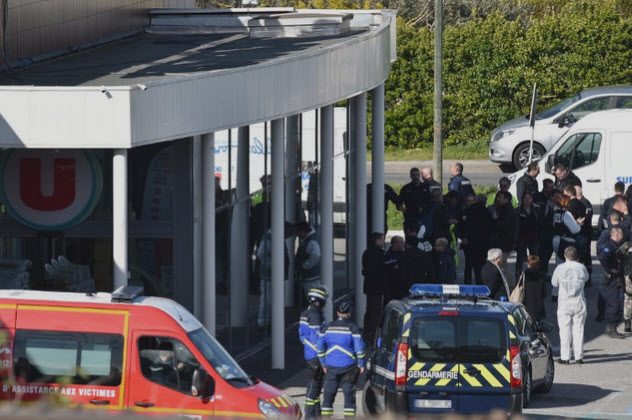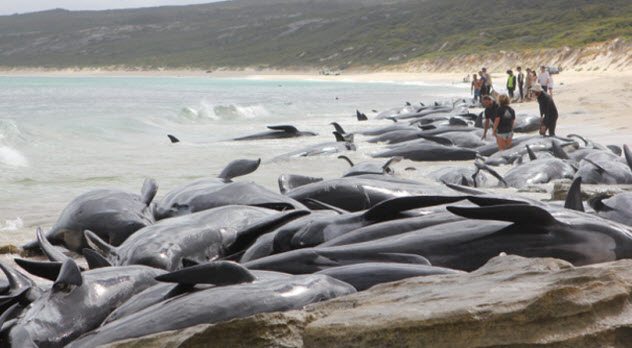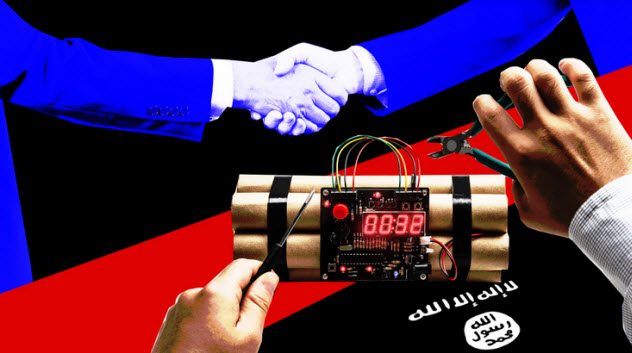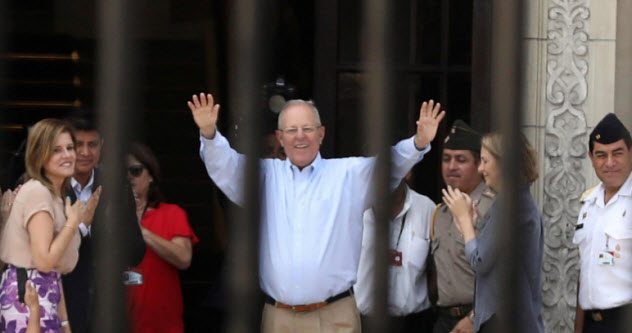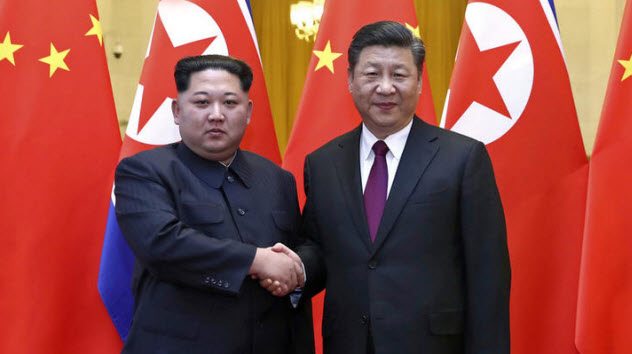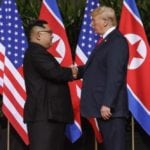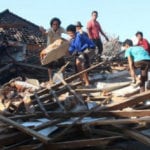After a quiet few months on the terrorism front, Islamist-inspired carnage finally returned to France this week, resulting in the first terrorism-related deaths of Emmanuel Macron’s presidency. Distressing as that was, the bigger tragedy this week took place many, many miles away in an unassuming cinema in Siberia. More on both disasters below, along with a look at the political earthquakes happening elsewhere across the world.
10 France Saw The First Fatal Terrorist Attack Of The Macron Era
Toward the end of last year, France’s parliament finally voted to lift the state of emergency in place since the deadly Paris attacks of 2015. It followed a relatively calm 2017 in which only one person died in Islamist-related terrorism. (There’s some confusion as to whether a deadly double stabbing in Marseille was a terrorist attack or just a random murder.) This weekend, that period of calm finally ended. An ISIS-affiliated gunman went on a rampage, taking hostages in the small town of Trebes. By the time he died in a hail of bullets, three people were dead. The attacker was a 26-year-old with seemingly little military training. After killing a bystander in a carjacking, he shot at a group of policemen before driving to a supermarket and opening fire. After taking hostages, he was convinced to exchange them for policeman Arnaud Beltrame, who was shot and died later in the hospital. Thanks to Beltrame’s bravery, a much-worse massacre was likely averted.[1] Bad as the attack was, it does highlight how the ISIS threat to France appears to be ebbing. Thankfully, the days of massacres with 80-plus casualties seem to be over.
9 Russia Suffered Its Deadliest Fire In Nearly A Decade
This weekend was a bad one for tragedy. The day after France’s supermarket siege, a fire broke out in a mall in the remote Siberian city of Kemerovo. Incredibly, fire exits were blocked at the time and a fire safety technician had disabled the public address system. The result was a horrific inferno which consumed the building, trapping people inside. At the time of this writing, 64 are confirmed dead and dozens remain missing. The blaze was Russia’s deadliest fire since the 2009 Perm nightclub inferno killed 156. While Sunday’s fire falls far short of that grim tally, the nature of the victims was far more shocking. Russian authorities put the number of children killed at 41, many of them in a cinema that collapsed as the fire raged.[2] Unsurprisingly, the public reaction has been one of untrammeled grief and anger, with mass protests paralyzing Kemerovo. Putin has called the blaze a case of criminal negligence. Five mall employees have now been arrested.
8 Germany Arrested Catalonia’s Independence Leader
The story has slipped out of the news cycle recently, but Catalonia has been in a constant state of crisis since an (admittedly flawed) referendum in October 2017 resulted in an attempted declaration of independence from Spain. We say “attempted” because the Spanish authorities clamped down hard and the regional leader, Carles Puigdemont, was forced to flee to Belgium. This week, Spain reissued an international arrest warrant against Puigdemont while he was in Finland. Puigdemont tried to flee back to Belgium, where he’s been granted asylum, but was intercepted by police in Germany. He is now in custody, awaiting possible extradition.[3] The arrest triggered mass protests and violence in Catalonia, where over 80 were injured in clashes with police. Spain wants to put Puigdemont on trial for sedition, which carries a 25-year sentence. However, it’s not a foregone conclusion that Germany will actually extradite the former Catalan leader. Courts in Germany now have 60 days to decide on the legality of Spain’s request. We’ll see what happens next.
7 A Porn Actress Went Public With Salacious Allegations Against US President Trump
It’s like the Clinton White House all over again. On Sunday, adult film actress Stormy Daniels went on CBS’s 60 Minutes to give details of an alleged fling she had with President Trump in 2006. Whether fact or fiction, the result was a morbidly compelling interview that garnered 60 Minutes its highest ratings in over a decade. The main allegations are this: Daniels claims that she had one-off consensual sex with Trump as part of a deal to get on The Apprentice. Since the president had already married Melania Trump by this point, such a claim, if true, would represent the sort of juicy scandal we haven’t seen since Slick Willie was in the Oval Office. Daniels also alleged that she was paid hush money to keep the affair quiet and that lawyer Michael Cohen had her physically threatened in Las Vegas.[4] It’s important to note that the president’s lawyers deny all of Daniels’s claims. It’s also worth noting that, if Daniels is telling the truth, the only person who should really be scandalized is Melania. (It’s not like Trump has cultivated a puritan image.) But still, this interview could yet cause headaches for the president, especially where the Christian vote is concerned.
6 A Mass Stranding In Australia Killed An Unbelievable Number Of Whales
Mass whale strandings are a strange but sadly very real phenomenon. Over the decades, whole pods have occasionally lost their ability to navigate and wound up dying dreadful, painful deaths on remote sandy shores. This weekend, Australia’s Hamelin Bay saw one of the country’s worst strandings in years. Over 150 short-finned pilot whales washed ashore on Friday. Only six survived. This isn’t the worst mass stranding in history. That honor probably goes to the beaching of 1,000 whales in New Zealand in 1918. Nor is it the worst of modern times. Four hundred pilot whales died just last year after coming ashore, also in New Zealand. Still, it’s one of the worst Australia has seen for some time. For anyone who loves animals or the environment, it’s a heartbreaking tragedy.[5] The exact cause of these mass strandings is unknown. Some theories point to sickness, while others point to the disorientating effects of sonar on the animals.
5 We Discovered More Details About ISIS’s First Latin American Plot
On March 15, an unlikely sounding story surfaced about the FBI uncovering ISIS’s first Latin American plot: a plan to blow up a restaurant in Bogota, Colombia. Unlikely, because only 0.03 percent of Colombia’s citizens identify as Muslim and most of them practice relatively moderate forms. Unlikely, too, because Colombian terrorism is generally related to politics or drugs. Yet this wasn’t a case of the FBI jumping the gun. It was a real plot. This week, we finally found out all the chilling details. Cuban national Raul Gutierrez had been in contact with ISIS and been provided with funds to construct a bomb. Under the direction of a terrorist cell in Spain and Morocco, he was planning to detonate the bomb in the restaurant at which he worked, one frequented by US embassy staff.[6] What’s scary about Gutierrez’s tale is that it suggests ISIS has found a new way to recruit from outside its traditional pool of true believers—by finding alienated non-Muslims, converting them, and supplying them with funds for committing an atrocity. It also suggests that the group is looking to export its brand of terrorism to a continent traditionally unbothered by Islamic extremism.
4 Peru’s Political Crisis Grew Ever More Acute
Last Friday, after this column had gone live, Martin Vizcarra was sworn in as the 67th president of Peru. His ascension to the highest office in his homeland was accompanied not by celebrations but by a feeling that Peru was standing on the edge of an abyss. A dramatic corruption scandal unfolding over the past few months has threatened to tip the South American nation into outright anarchy. The scandal is linked to Odebrecht, a Brazilian company at the center of what’s been called the biggest bribery investigation in history. Odebrecht is alleged to have bribed Pedro Pablo Kuczynski, Vizcarra’s predecessor who stepped down last week before he could be impeached. In December 2017, Kuczynski had pardoned and freed Peru’s former dictator, Alberto Fujimori, in what was widely seen as a sop to Fujimori’s old party to stop them from impeaching Kuczynski. The deal sparked mass protests in Peru, protests that have only gotten bigger as more and more of Kuczynski’s alleged financial crimes come to light.[7] As things currently stand, Kuczynski has been barred from leaving the country and the entire government seems on the verge of implosion. To say Vizcarra has his work cut out for him would be an understatement.
3 The FBI Arrested The Leader Of An Alleged Sex Trafficking Cult
NXIVM may sound like a nerve gas, but it’s actually the name of what may be one of the strangest cults in recent US history. Founded as a self-help group in 1998 by leader Keith Raniere, it bills itself as an ethical, enlightened, and humanitarian organization. The FBI believes differently. Last month, they issued an arrest warrant for Raniere, alleging that NXIVM was a bizarre combination of pyramid scheme and sex cult. The lurid tales read like a rejected script from an early ’90s sexploitation thriller. Raniere allegedly kept 50 devoted women as slaves. He branded them with his initials in a religious ceremony, required them to have sex with him, and kept them on absurdly controlled diets. The enslaved women were also required to groom and recruit more slaves for Raniere and provide compromising details so that NXIVM could blackmail the women if they tried to leave.[8] On Sunday, justice may have finally caught up with Raniere. He was arrested in Mexico and now faces charges, including conspiracy to commit forced labor and sex trafficking. If found guilty, he could spend 15 years in jail.
2 Kim Jong Un Went To China
In 1972, Richard Nixon stunned the political world by going to China. His visit marked the beginning of the Middle Kingdom’s emergence from the deathless cult of Mao and into the (relatively) open global player the country is today. This week, that old visit by Nixon was on many minds as another leader made his first, impulsive trip to China, possibly beginning a process that could result in the normalization of another closed-off country. On Wednesday, it was announced that Kim Jong Un had left North Korea on his first foreign trip as leader. He went to Beijing, apparently to get Xi Jinping’s blessing for upcoming meetings with Seoul and Washington aimed at convincing Pyongyang to denuclearize.[9] The visit was both secretive and highly symbolic. So far, Kim has spent his time as leader as closed off as his country. His visit to Beijing—and China’s subsequent announcement that North Korea is prepared to give up its nukes—suggests that Kim’s upcoming meetings with President Moon of South Korea and President Trump aren’t just false promises. They may be the beginning of a genuine thaw. We can only hope.
1 We Saw The Biggest Youth Protests Since The Vietnam War
A frequent complaint about millennials is that they’re apathetic hipsters more concerned with moaning about things than trying to change them. If Sunday’s protests are anything to go by, the next generation does not have that problem. The March for Our Lives, organized by survivors of the Parkland mass shooting in February, drew crowds of teenagers not seen this side of Vietnam. In Washington, the air fairly crackled with the promise of change. Despite what the organizers claim, these weren’t the biggest protests in DC history. The lower estimate for the Washington crowd was about 200,000, which would put it easily behind both the Women’s March and the Million Man March. But March for Our Lives protests were the biggest youth-led ones in modern memory, and they showcased a generation of speakers whose eloquence and passion made the Occupy protesters seem like a dim and embarrassing memory. What changes may actually come from these protests is debatable. Previous Supreme Court rulings suggest that the Second Amendment is not open for reinterpretation. But it was still overwhelming to see a whole new generation making their voices heard and doing so with a purpose that evoked the great student speakers of the anti–Vietnam War or pro–Civil Rights movements.[10] The protesters’ de facto leader, Emma Gonzalez, has said they are the students we will read about in history books. She could yet be right.
